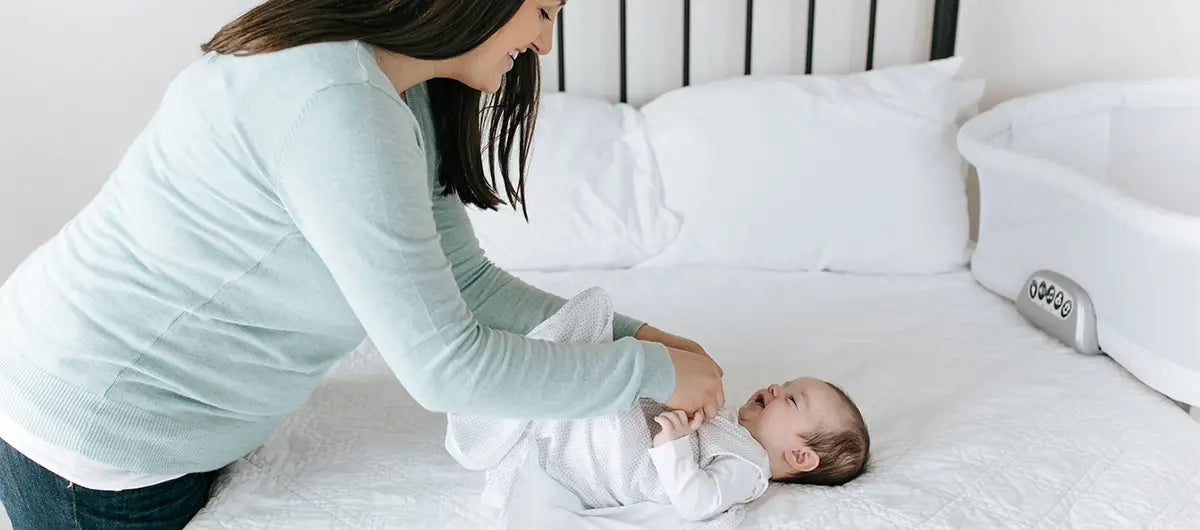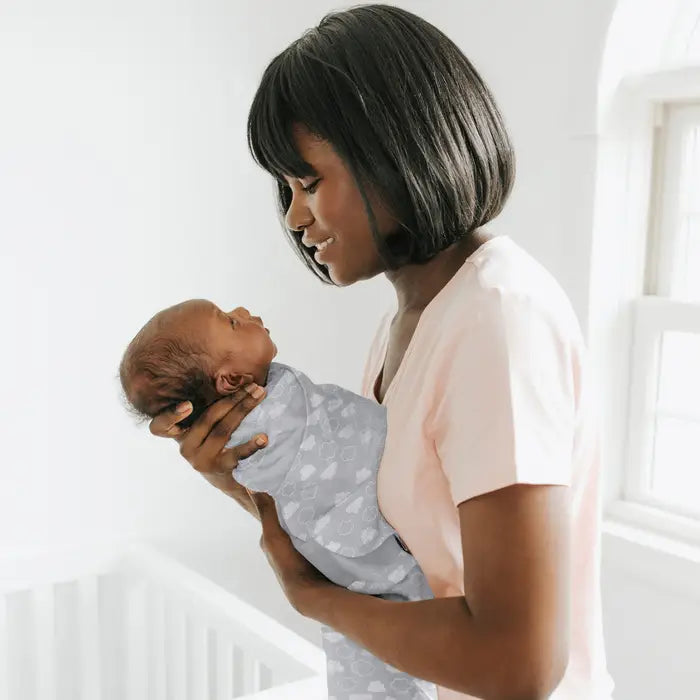TIPS FOR SAFE SWADDLING

Swaddling has been a cherished practice for centuries, providing comfort and security to newborns as they transition to the outside world. The gentle embrace of a swaddle can soothe a fussy baby and promote better sleep patterns. However, it's crucial to ensure that swaddling is done correctly and safely to avoid any potential risks.
In this blog post, we'll delve into the art of safe swaddling, sharing essential tips and techniques to help you create a cozy and secure environment for your little one. From selecting the right materials to practicing proper techniques, let's explore the key steps to swaddle your baby safely and confidently.
Swaddling is a time-honored practice that has provided comfort and security to newborns for generations. The art of wrapping a baby snugly in a soft blanket not only mimics the cozy environment of the womb but also helps soothe fussiness and promote better sleep. However, while swaddling offers many benefits, it's essential to prioritize safety and ensure that this practice is carried out correctly. In this comprehensive guide, we will delve into the world of safe swaddling, sharing essential tips and techniques to help you create a nurturing and secure environment for your little one. From choosing the right materials to mastering proper techniques, let's explore the key steps to ensure your baby is wrapped in comfort and safety during every sleep time.

The Benefits of Swaddling
Swaddling has long been recognized for its multitude of benefits, both for babies and their caregivers. Understanding these advantages can help you appreciate why swaddling is a cherished practice. Here are some key benefits:
- Comfort and Security: Swaddling creates a familiar and comforting environment for newborns, reminiscent of the cozy confines of the womb. The snugness of the swaddle provides a sense of security, helping babies feel calm and reassured. Also, newborns have a strong startle reflex that can wake them up abruptly during sleep. Swaddling can effectively limit the jerky movements caused by this reflex, promoting more peaceful sleep and longer rest periods.
- Better Sleep Patterns: The feeling of being gently wrapped can help babies feel more settled and relaxed, leading to longer and more restful sleep. Swaddling can prevent unnecessary awakenings due to the startle reflex or spontaneous arm movements. By providing a gentle constraint, it promotes uninterrupted sleep, allowing both baby and parents to enjoy longer stretches of rest.
- Reduced Colic and Fussiness: Swaddling can have a calming effect on babies, helping to alleviate colic symptoms and reduce excessive crying or fussiness. The snugness of the swaddle can provide a gentle pressure that mimics a comforting touch. Swaddling canSwaddling can make the transition from being held or rocked to being placed in a crib or bassinet more seamless, promoting a smoother shift in sleep environments., as the restricted movement can help babies focus on settling themselves, rather than becoming overwhelmed by their own limbs.
- Easier Transition to Sleep Routines: Associating swaddling with sleep cues can establish a consistent routine and signal to babies that it's time to rest. Over time, the act of swaddling can become an effective sleep cue, preparing them for slumber. Swaddling can make the transition from being held or rocked to being placed in a crib or bassinet more seamless, promoting a smoother shift in sleep environments.
Safe Swaddling Techniques
Proper swaddling techniques are vital to ensure your baby's safety and comfort.
The diamond swaddle technique is a popular method that involves folding the blanket into a diamond shape and securely wrapping it around your baby's body, allowing for freedom of movement in their legs. This technique helps to limit the risk of hip dysplasia by keeping the legs in a natural position.
The square swaddle technique is another commonly used method where the blanket is folded into a square shape and wrapped snugly around your baby, providing a secure and cozy swaddle. It's important to ensure that the swaddle is not too tight, as this can restrict breathing or cause discomfort. Checking for proper circulation and ensuring your baby's hips and legs have room to move freely are essential considerations.
For added convenience and ease, sleep sacks with built-in swaddle wings or adjustable fasteners can be a safe alternative to traditional swaddling with blankets. These sleep sacks provide a secure swaddle while allowing for proper leg movement. When using a sleep sack, it's crucial to ensure a proper fit, with a snug torso and enough room for natural leg positioning. Look for sleepsack swaddles that promote healthy-hip development.
Always monitor your baby during swaddling to ensure their face remains uncovered, and they do not overheat. It's crucial to follow safe sleep practices by placing your baby on their back to sleep and ensuring a comfortable sleep environment. As your baby grows and begins to show signs of rolling over, it's important to transition away from swaddling to maintain their safety.
SleepSack Swaddling
A SleepSack Swaddle combines the benefits of a sleep sack and a swaddle, providing a safe and convenient option for newborns and young infants. Sleepsack swaddles typically have a pouch for the legs and a secure wrap or wings for the upper body. They help to take the guesswork of learning how to swaddle (hassle-free? YES PLEASE!) They have adjustable closures making it easier to achieve a snug and secure fit.
Need help learning how to use your SleepSack Swaddle? Learn how to below!

Recongizing and Addressing Safety Concerns
While swaddling can provide numerous benefits, it's important to be aware of potential safety concerns and address them appropriately. Here are some key considerations to ensure your baby's safety during swaddling:
- Overheating: Ensure your baby isn't overdressed beneath the swaddle. Use lightweight, breathable clothing suitable for the room temperature. Avoid your baby overheating at night by keeping the room at a comfortable temperature. Feel your baby's chest or back to check if they feel warm rather than hot. Pro tip: reference a TOG chart to help determine how to dress your baby for a specific temperature. Learn more about TOG here.
- Proper Circulation: Make sure the swaddle is snug but not too tight. You should be able to comfortably slide two fingers between the swaddle and your baby's chest. It is essential to leave enough room for the hips to move and to allow for proper hip development. The legs should be able to bend up and out at the hips. The baby's legs should not be tightly wrapped together or forced into a straight position as this can increase the risk of hip dysplasia. Learn more about healthy-hip swaddling.
- Safe Sleep Position: Back is best! Place your baby on their back to sleep whether swaddled or not. This position reduces the risk of Sudden Infant Death Syndrome. Avoid adding loose blankets, toys or other items in the sleep area to minimize suffocation hazards.
Swaddling should be discontinued when your baby shows signs of rolling over or breaking free from the swaddle wrap. When this occurs, transition your baby into a HALO SleepSack® wearable blanket. While it varies for every baby, generally a baby should not be swaddled past 4 months.
Alternatives to Traditional Swaddling
If swaddling isn't working for you or your baby, it is time to search for alternatives. There are a few options to consider.
Swaddle blankets with hook and loop or zipper closures: These blankets are designed to make swaddling easier and more secure. They eliminate the need for intricate folding and wrapping techniques and provide a snug fit without restricting the baby's hip movement. They also make it easier to adjust the tightness of the swaddle.
Sleep sacks or Wearable Blankets: Sleep sacks are wearable blankets with armholes that allow the baby to move their arms while keeping the rest of their body covered. They provide a cozy and secure feeling without fully restricting the baby's movement. Sleep sacks come in different sizes and weights suitable for different seasons.
Swaddle transition products: As babies grow older and start to roll over, traditional swaddling becomes unsafe. Swaddle transition products are designed to help babies transition from being swaddled to having their arms free. They usually have a snug fit around the torso but allow the baby to have their arms out.

About the HALO SleepSack® Swaddle
Every baby has different sleep preferences. The adjustable HALO® SleepSack swaddle provides 3 easy ways to swaddle to ensure your baby’s best sleep and to help make the transition from swaddling easier.
Swaddle arms in, one or both arms out to ensure baby’s best sleep and an easy and gentle transition to the SleepSack wearable blanket when it is time to stop swaddling. It’s the easy and safe way to swaddle.
The convinent access for easy diaper changes, hip healthy sack design and strong, adjustable fasteners, ensure the perfect, secure swaddle everytime.
Learn more about the HALO SleepSack Swaddle here.

